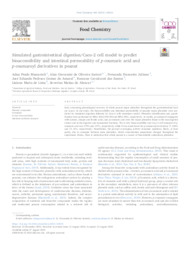Simulated gastrointestinal digestion/Caco-2 cell model to predict bioaccessibility and intestinal permeability of p-coumaric acid and p-coumaroyl derivatives in peanut.
Simulated gastrointestinal digestion/Caco-2 cell model to predict bioaccessibility and intestinal permeability of p-coumaric acid and p-coumaroyl derivatives in peanut.
Author(s): MASSARIOLI, A. P.; SARTORI, A. G. de O.; JULIANO, F. F.; AMARAL, J. E. P. G. do; SANTOS, R. C. dos; LIMA, L. M. de; ALENCAR, S. M. de
Summary: Data concerning physiological recovery of whole peanut major phenolics throughout the gastrointestinal tract are scarce. In our study, the bioaccessibility and intestinal permeability of peanuts major phenolics were predicted by simulated digestion followed by Caco-2 cells monolayer model. Phenolics identification and quantification were performed by HPLC-ESI-QTOF-MS and HPLC-PDA, respectively. As results, p-coumaroyl conjugates with tartaric, sinapic and ferulic acids, and p-coumaric acid were the major phenolics found in the non-digested extract and in the digested and transported fractions. The in vitro bioaccessibility and Caco-2 cell transport of pcoumaric acid was 370% and 127%, respectively, while it was much lower for p-coumaroyl derivatives (7-100% and 14-31%, respectively). Nonetheless, the peroxyl scavenging activity remained unaltered, likely, at least artly, due to synergies between some phenolics, which concentration proportions changed throughout the experiment. Hence, there is indication that whole peanut is a source of bioavailable antioxidant phenolics.
Publication year: 2023
Types of publication: Journal article
Unit: Embrapa Cotton
Keywords: Amendoim, Arid zones, Nutrição Humana, Peanuts, Phenolic compounds, Proteína Vegetal, Óleo Vegetal
Observation
Some of Embrapa's publications are published as ePub files. To read them, use or download one of the following free software options to your computer or mobile device. Android: Google Play Books; IOS: iBooks; Windows and Linux: Calibre.
Access other publications
Access the Agricultural Research Database (BDPA) to consult Embrapa's full library collection and records.
Visit Embrapa Bookstore to purchase books and other publications sold by Embrapa.

